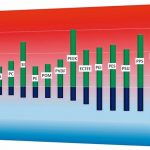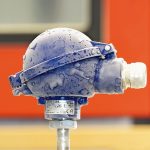Firmen im Artikel
New oil and gas fields are still being developed and mined despite far-reaching concepts for alternative energy sources. The majority of these activities are concentrated in parts of Siberia and northern Canada, where an Arctic climate prevails for several months of the year. The increase in oil and gas extraction in these regions and the need to process it locally have resulted in a growing demand for electrical thermometers which are suited for low ambient temperatures, notably for monitoring and controlling processes in petrochemical plants.
A glance at the climate chart shows that operators will not get far with standard products under these conditions. Resistance thermometers are normally rated for ambient temperatures down to -40 °C. In regions where extreme cold is a common occurrence, that is not enough. A test temperature of at least -60 °C is meanwhile used for all measuring instruments destined for these latitudes. Developing and specifying suitable thermometers presents manufacturers with daunting challenges. The materials, components and design must ensure permanent resistance to low temperatures.
In the field or in the control cabinet
At the heart of any resistance thermometer are the electrics. The measuring resistor itself – usually a Pt100 sensor – can survive low ambient temperatures without any problems. However, it’s a different situation with the transmitter which converts the measured value into an interference-free output signal. In this case, users must decide whether the transmitter should be integrated into the measuring instrument’s connection head or installed in the control cabinet in the control room.
With head-mounted types, the transmitter is close to the sensor, so that the resistance signal’s susceptibility to failure is reduced to a minimum. On the other hand, it is directly exposed to the extreme sub-zero temperatures. Transmitters installed in the control cabinet work at the specified room temperature and hence provide better overall accuracy. Then again, users must check upfront for possible impacts on the connection between the measuring point and the transmitter and counter them if necessary by choosing a higher cable quality.
They must also clarify in advance whether a local indication is required at the measuring point, because physical effects due to cold are often observed on thermometers with an LC display. The crystals start to freeze at ambient temperatures below -20 °C. If the temperature rises above this value again, the display function may be restored following a time delay, especially with low loop currents. The LC display must not be destroyed at temperatures down to at least -60 °C, and the instrument must work normally again after the temperature rises.
If the measured values must be indicated continuously on site, either a second measuring point with a dial thermometer must be provided or a mechatronic measuring arrangement selected. Additional effort is necessary to specify either of these solutions as low temperature resistant.
Use of suitable materials
The service life and functionality of electrical thermometers at extreme sub-zero temperatures are principally determined by the behaviour of the plastics which are used. As a rule of thumb, the brittleness of a plastic increases the lower the ambient temperature. At a test temperature of -60 °C, standard materials soon reach their limits and become brittle. Extensive damage can be caused to the device in this way, so that the process no longer functions reliably. Certain components such as cable glands are often made of metal from the outset for this reason.
In spite of this, measurement solutions which are completely devoid of plastic remain a utopia (take the seals, for example). The materials which are selected must consequently be suitable for low ambient temperatures. Although this condition is nominally fulfilled by high-quality plastics, right down to -250 °C, the optimum choice is in fact guided by the place of use during the measurement because it is this that determines the required elasticity. Seals which work in static environments are less of a problem.
This does not apply when it comes to the sheaths for insulating cables, for instance. These should not normally be moved, in order to prevent micro-cracks and moisture ingress. That also includes vibration and thermal effects (expansion or contraction). All cables must therefore be laid so that they are stationary. Outgoing cables should be laid in ducts along a wall or – provided the process temperature does not distort the measured value – the piping.
Apart from seals and cable sheaths, various other components containing plastics exist which must likewise be considered, for example sealing compounds, adhesives or painted surfaces. Particularly if the devices are used in hazardous areas, the electrical conductivity of these materials must be taken into account as well.
Caution is similarly advised with components made of metal. Stainless steel poses no problems whatsoever at low ambient temperatures. Aluminium alloys are far more vulnerable, as a comparative drop test shows: aluminium parts exhibit different kinds of – and also more severe – damage at low temperatures than they do at room temperature. Critical components like connection heads or cable glands are generally manufactured from stainless steel for this reason. Aluminium alloys should only be used at those measuring points where physical effects (impact or shock) can be ruled out.
Complex test series
Complex test series are unavoidable to verify whether an electrical thermometer is capable of withstanding the extreme requirements described here in practice. Both the ready-to-use measuring instrument and its individual components undergo tests to determine their temperature cycling resistance as per IEC 60079-0 and their IP protection according to IEC 60529. The fully assembled device is additionally subjected to an impact resistance test, which is explicitly carried out at the weakest points on the outside. A tool is applied to the surfaces concerned by a machine to see whether flaking or cracking is likely. Thermometers intended for hazardous areas (EAC-Ex) are required to complete these tests with a “safety margin”: instead of being tested at an operating temperature of -60 °C, they are placed in a special climatic test chamber at -70 °C to preclude every conceivable risk to process reliability.
The results of the test series are comprehensively documented. Once the device has been approved, this is confirmed to the customer with a comment in the delivery note.
Online search: cpp0218wika
Hall 11.1, Booth C3











